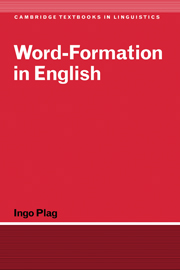Book contents
- Frontmatter
- Contents
- Preface
- Abbreviations and notational conventions
- Introduction
- 1 Basic concepts
- 2 Studying complex words
- 3 Productivity and the mental lexicon
- 4 Affixation
- 5 Derivation without affixation
- 6 Compounding
- 7 Theoretical issues: modeling word-formation
- Answer key to exercises
- References
- Subject index
- Affix index
- Author index
4 - Affixation
- Frontmatter
- Contents
- Preface
- Abbreviations and notational conventions
- Introduction
- 1 Basic concepts
- 2 Studying complex words
- 3 Productivity and the mental lexicon
- 4 Affixation
- 5 Derivation without affixation
- 6 Compounding
- 7 Theoretical issues: modeling word-formation
- Answer key to exercises
- References
- Subject index
- Affix index
- Author index
Summary
Outline
This chapter provides an overview of the affixational word-formation processes of English. First, it discusses how affixes can be distinguished from other entities. This is followed by an introduction to the methodological problems of data gathering for the study of affixation through dictionaries and electronic corpora. Then some general properties that characterize the system of English affixation are introduced, and a survey of a wide range of suffixes and prefixes is presented. Finally, we investigate cases of infixation.
What is an affix?
In chapter 1 we defined ‘affix’ as a bound morpheme that attaches to bases. Although this seems like a clear definition, there are at least two major problems. First, it is not always easy to say whether something is a bound morpheme or a free morpheme, and second, it is not always obvious whether something should be regarded as a base or an affix. We will discuss each problem in turn.
Consider the data in (1) through (4), which show the putative affixes -free, -less, -like, and -wise in a number of derivatives, illustrated with quotations from the BNC:
(1) There was never an error-free text, Cropper said.
(2) Now the lanes were carless, lawless.
(3) Arriving on her broomstick at the prison-like school gates, Mildred peered through the railings into the misty playground.
(4) She had been a teacher, and made sure the girl went to a good school: “my granny had more influence on me education-wise.”
- Type
- Chapter
- Information
- Word-Formation in English , pp. 72 - 106Publisher: Cambridge University PressPrint publication year: 2003



